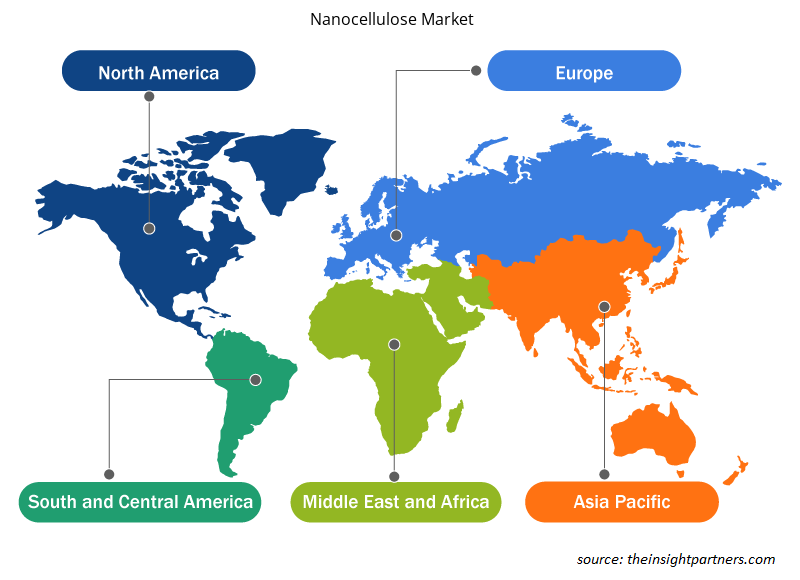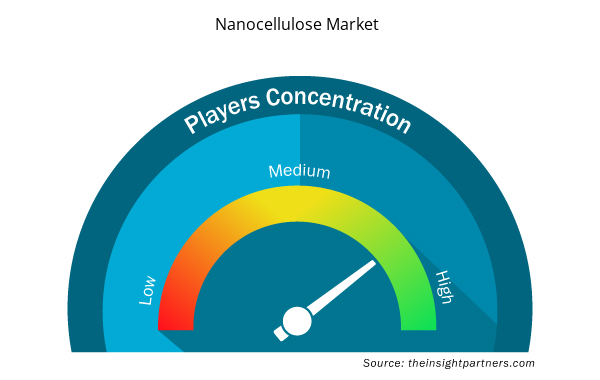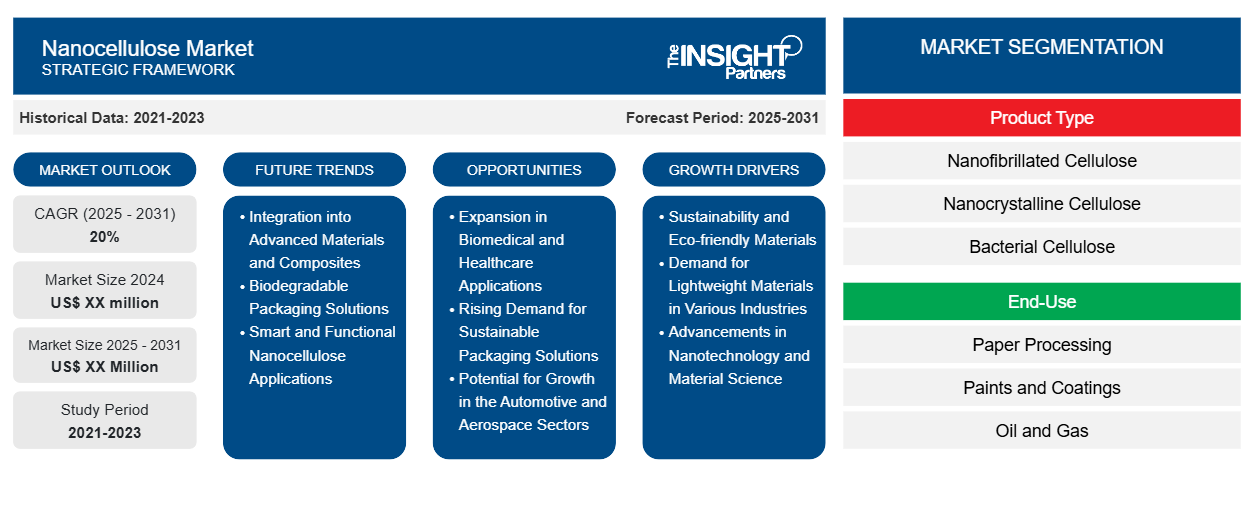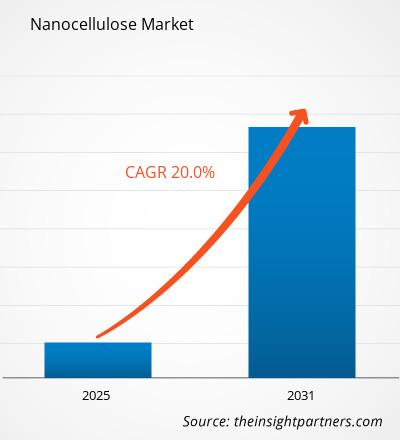Si prevede che il mercato della nanocellulosa registrerà un CAGR del 20% dal 2024 al 2031, con una dimensione di mercato in espansione da XX milioni di dollari nel 2024 a XX milioni di dollari entro il 2031.
Il rapporto è suddiviso in base al tipo di prodotto ( cellulosa nanofibrillata (NFC), cellulosa nanocristallina ( NCC ), cellulosa batterica, cellulosa microfibrillata ( MFC ) e altri). Il rapporto presenta analisi basate sull'uso finale (lavorazione della carta, vernici e rivestimenti, petrolio e gas, alimenti e bevande, compositi, prodotti farmaceutici, cosmetici e altri). L'analisi globale è ulteriormente suddivisa a livello regionale e nei principali paesi. Il rapporto offre il valore in USD per l'analisi e i segmenti di cui sopra.
Scopo del rapporto
Il rapporto Nanocellulosa Market di The Insight Partners mira a descrivere il panorama attuale e la crescita futura, i principali fattori trainanti, le sfide e le opportunità. Ciò fornirà spunti a vari stakeholder aziendali, come:
- Fornitori/produttori di tecnologia: per comprendere le dinamiche di mercato in evoluzione e conoscere le potenziali opportunità di crescita, consentendo loro di prendere decisioni strategiche informate.
- Investitori: condurre un'analisi completa delle tendenze in merito al tasso di crescita del mercato, alle proiezioni finanziarie del mercato e alle opportunità esistenti lungo la catena del valore.
- Enti di regolamentazione: regolamentano le politiche e le attività di controllo sul mercato allo scopo di ridurre al minimo gli abusi, preservare la fiducia degli investitori e sostenere l'integrità e la stabilità del mercato.
Segmentazione del mercato della nanocellulosa
Tipo di prodotto
- NanofibrillatoCellulosa
- NanocristallinoCellulosa
- Cellulosa batterica
- MicrofibrillatoCellulosa
- Altri
Uso finale
- Lavorazione della carta
- Vernici e rivestimenti
- Petrolio e gas
- Cibo e bevande
- Compositi
- Prodotti farmaceutici
- Cosmetici
- Altri
Personalizza questo report in base alle tue esigenze
Riceverai la personalizzazione gratuita di qualsiasi report, comprese parti di questo report, o analisi a livello nazionale, pacchetto dati Excel, oltre a usufruire di grandi offerte e sconti per start-up e università
- Scopri le principali tendenze di mercato in questo rapporto.Questo campione GRATUITO includerà analisi di dati che spaziano dalle tendenze di mercato alle stime e alle previsioni.
Fattori trainanti della crescita del mercato della nanocellulosa
- Sostenibilità e materiali eco-compatibili: la crescente enfasi sui materiali sostenibili e biodegradabili è un fattore chiave per il mercato della nanocellulosa. La nanocellulosa, derivata da fibre vegetali rinnovabili, fornisce un'alternativa ecologica ai materiali sintetici come la plastica. Mentre le industrie si sforzano di ridurre il loro impatto ambientale e adottare tecnologie verdi, la nanocellulosa sta guadagnando terreno in applicazioni che spaziano dal packaging ai tessuti e ai prodotti farmaceutici.
- Domanda di materiali leggeri in vari settori: la nanocellulosa offre un eccellente rapporto resistenza/peso, rendendola un materiale ideale per settori quali automotive, aerospaziale e edilizia. La crescente domanda di materiali leggeri e ad alte prestazioni in questi settori sta guidando il mercato. I compositi a base di nanocellulosa offrono proprietà meccaniche superiori riducendo al contempo il peso, contribuendo all'efficienza del carburante e a prestazioni migliorate.
- Progressi nella nanotecnologia e nella scienza dei materiali: le innovazioni in corso nella nanotecnologia stanno consentendo lo sviluppo di prodotti in nanocellulosa ad alte prestazioni. La ricerca sul suo utilizzo in elettronica, rivestimenti e dispositivi medici sta aprendo nuove strade per la crescita. Man mano che il potenziale del materiale in applicazioni avanzate diventa più evidente, si prevede che la sua adozione sul mercato accelererà.
Tendenze future del mercato della nanocellulosa
- Integrazione in materiali avanzati e compositi: il futuro del mercato della nanocellulosa sarà fortemente influenzato dalla sua integrazione in materiali e compositi ad alte prestazioni. La capacità della nanocellulosa di migliorare la resistenza, la flessibilità e la resistenza all'acqua la rende un candidato ideale per lo sviluppo di materiali leggeri e durevoli utilizzati in settori quali aerospaziale, automobilistico e delle costruzioni. Poiché sempre più settori cercano alternative ecologiche e ad alte prestazioni, la nanocellulosa svolgerà un ruolo fondamentale nello spazio dell'innovazione dei materiali.
- Soluzioni di imballaggio biodegradabili: la spinta verso la riduzione dei rifiuti di plastica guiderà l'adozione della nanocellulosa negli imballaggi biodegradabili. La natura sostenibile e rinnovabile della nanocellulosa la rende un'alternativa interessante alle plastiche convenzionali, specialmente negli imballaggi alimentari e nei prodotti monouso. Le tendenze future puntano verso una maggiore commercializzazione di imballaggi a base di nanocellulosa che offrono resistenza, resistenza all'umidità e biodegradabilità, soddisfacendo sia le preoccupazioni ambientali sia le preferenze dei consumatori per soluzioni ecocompatibili.
- Applicazioni intelligenti e funzionali della nanocellulosa: si prevede che la nanocellulosa verrà sempre più utilizzata in applicazioni che vanno oltre i materiali tradizionali, come rivestimenti funzionali, dispositivi medici e tessuti intelligenti. La ricerca in corso sta esplorando il suo potenziale nella creazione di materiali auto-riparanti, sistemi di somministrazione di farmaci e sensori. Con la maturazione di queste tecnologie, si prevede che la domanda di nanocellulosa in applicazioni high-tech crescerà in modo significativo.
Opportunità di mercato della nanocellulosa
- Espansione nelle applicazioni biomediche e sanitarie: la nanocellulosa ha un potenziale significativo nei campi biomedici, come la cura delle ferite, la somministrazione di farmaci e l'ingegneria tissutale. La sua biocompatibilità e resistenza la rendono ideale per lo sviluppo di dispositivi medici e scaffold di origine biologica. Con l'aumento della domanda di materiali naturali e sostenibili nel settore sanitario, la nanocellulosa è ben posizionata per diventare un attore chiave in queste applicazioni mediche avanzate.
- Domanda crescente di soluzioni di imballaggio sostenibili: la crescente domanda dei consumatori di imballaggi eco-compatibili offre un'importante opportunità per il mercato della nanocellulosa. Come alternativa alla plastica, gli imballaggi a base di nanocellulosa possono fornire una soluzione biodegradabile, leggera e ad alte prestazioni. Aziende e governi stanno dando sempre più priorità alle pratiche sostenibili, il che alimenterà la domanda di materiali innovativi in nanocellulosa nelle applicazioni di imballaggio.
- Potenziale di crescita nei settori automobilistico e aerospaziale: le proprietà leggere, resistenti e durevoli della nanocellulosa la rendono un'opzione interessante per i compositi utilizzati nei settori automobilistico e aerospaziale. Poiché questi settori danno priorità alla riduzione del peso per migliorare l'efficienza del carburante e le prestazioni complessive, la nanocellulosa potrebbe diventare un componente fondamentale nei materiali leggeri, offrendo un'importante opportunità di crescita.
Approfondimenti regionali sul mercato della nanocellulosa
Le tendenze regionali e i fattori che influenzano il mercato della nanocellulosa durante il periodo di previsione sono stati ampiamente spiegati dagli analisti di Insight Partners. Questa sezione discute anche i segmenti e la geografia del mercato della nanocellulosa in Nord America, Europa, Asia Pacifico, Medio Oriente e Africa e America meridionale e centrale.

- Ottieni i dati specifici regionali per il mercato della nanocellulosa
Ambito del rapporto sul mercato della nanocellulosa
| Attributo del report | Dettagli |
|---|---|
| Dimensioni del mercato nel 2024 | XX milioni di dollari USA |
| Dimensioni del mercato entro il 2031 | XX milioni di dollari USA |
| CAGR globale (2025 - 2031) | 20% |
| Dati storici | 2021-2023 |
| Periodo di previsione | 2025-2031 |
| Segmenti coperti | Per tipo di prodotto
|
| Regioni e Paesi coperti | America del Nord
|
| Leader di mercato e profili aziendali chiave |
|
Densità degli attori del mercato della nanocellulosa: comprendere il suo impatto sulle dinamiche aziendali
Il mercato della nanocellulosa sta crescendo rapidamente, spinto dalla crescente domanda degli utenti finali dovuta a fattori quali l'evoluzione delle preferenze dei consumatori, i progressi tecnologici e una maggiore consapevolezza dei benefici del prodotto. Con l'aumento della domanda, le aziende stanno ampliando le loro offerte, innovando per soddisfare le esigenze dei consumatori e capitalizzando sulle tendenze emergenti, il che alimenta ulteriormente la crescita del mercato.
La densità degli operatori di mercato si riferisce alla distribuzione di aziende o società che operano in un particolare mercato o settore. Indica quanti concorrenti (operatori di mercato) sono presenti in un dato spazio di mercato in relazione alle sue dimensioni o al valore di mercato totale.
Le principali aziende che operano nel mercato della nanocellulosa sono:
- Società Americana di Process Inc.
- Borregaard ASA
- Società: Celluforce Inc.
- Azienda produttrice di Daicel FineChem Ltd.
- Innventia AB
Disclaimer : le aziende elencate sopra non sono classificate secondo un ordine particolare.

- Ottieni una panoramica dei principali attori del mercato della nanocellulosa
Punti chiave di vendita
- Copertura completa: il rapporto copre in modo completo l'analisi di prodotti, servizi, tipologie e utenti finali del mercato della nanocellulosa, fornendo una panoramica olistica.
- Analisi degli esperti: il rapporto è compilato sulla base della conoscenza approfondita di esperti e analisti del settore.
- Informazioni aggiornate: il rapporto garantisce la pertinenza aziendale grazie alla copertura di informazioni recenti e tendenze nei dati.
- Opzioni di personalizzazione: questo report può essere personalizzato per soddisfare le esigenze specifiche del cliente e adattarsi in modo appropriato alle strategie aziendali.
Il rapporto di ricerca sul mercato della nanocellulosa può quindi aiutare a guidare il percorso di decodifica e comprensione dello scenario del settore e delle prospettive di crescita. Sebbene possano esserci alcune preoccupazioni valide, i vantaggi complessivi di questo rapporto tendono a superare gli svantaggi.
- Analisi storica (2 anni), anno base, previsione (7 anni) con CAGR
- Analisi PEST e SWOT
- Valore/volume delle dimensioni del mercato - Globale, regionale, nazionale
- Industria e panorama competitivo
- Set di dati Excel



Report Coverage
Revenue forecast, Company Analysis, Industry landscape, Growth factors, and Trends

Segment Covered
This text is related
to segments covered.

Regional Scope
North America, Europe, Asia Pacific, Middle East & Africa, South & Central America

Country Scope
This text is related
to country scope.
Domande frequenti
Based on geography, Asia Pacific held the largest share of the nanocellulose market.
Integration into advanced materials and composites is expected to be the key market trends.
Based on product type, nanocrystalline cellulose (NCC) is expected to witness the fastest growth during the forecast period
American Process Inc, #Borregaard ASA, Celluforce Inc. are some of the key players operating in the nanocellulose market
Sustainability and eco-friendly materials is driving the nanocellulose market growth
The Nanocellulose Market is estimated to witness a CAGR of 20% from 2023 to 2031
Trends and growth analysis reports related to Chemicals and Materials : READ MORE..
The List of Companies
- American Process Inc.
- Borregaard ASA
- Celluforce Inc.
- Daicel FineChem Ltd.
- Innventia AB
- Kruger Inc.
- Nippon Paper Industries Co., Ltd.
- Norske Skogindustrier ASA
- Stora Enso Oyj
- UPM-Kymmene Oyj
The Insight Partners performs research in 4 major stages: Data Collection & Secondary Research, Primary Research, Data Analysis and Data Triangulation & Final Review.
- Data Collection and Secondary Research:
As a market research and consulting firm operating from a decade, we have published and advised several client across the globe. First step for any study will start with an assessment of currently available data and insights from existing reports. Further, historical and current market information is collected from Investor Presentations, Annual Reports, SEC Filings, etc., and other information related to company’s performance and market positioning are gathered from Paid Databases (Factiva, Hoovers, and Reuters) and various other publications available in public domain.
Several associations trade associates, technical forums, institutes, societies and organization are accessed to gain technical as well as market related insights through their publications such as research papers, blogs and press releases related to the studies are referred to get cues about the market. Further, white papers, journals, magazines, and other news articles published in last 3 years are scrutinized and analyzed to understand the current market trends.
- Primary Research:
The primarily interview analysis comprise of data obtained from industry participants interview and answers to survey questions gathered by in-house primary team.
For primary research, interviews are conducted with industry experts/CEOs/Marketing Managers/VPs/Subject Matter Experts from both demand and supply side to get a 360-degree view of the market. The primary team conducts several interviews based on the complexity of the markets to understand the various market trends and dynamics which makes research more credible and precise.
A typical research interview fulfils the following functions:
- Provides first-hand information on the market size, market trends, growth trends, competitive landscape, and outlook
- Validates and strengthens in-house secondary research findings
- Develops the analysis team’s expertise and market understanding
Primary research involves email interactions and telephone interviews for each market, category, segment, and sub-segment across geographies. The participants who typically take part in such a process include, but are not limited to:
- Industry participants: VPs, business development managers, market intelligence managers and national sales managers
- Outside experts: Valuation experts, research analysts and key opinion leaders specializing in the electronics and semiconductor industry.
Below is the breakup of our primary respondents by company, designation, and region:

Once we receive the confirmation from primary research sources or primary respondents, we finalize the base year market estimation and forecast the data as per the macroeconomic and microeconomic factors assessed during data collection.
- Data Analysis:
Once data is validated through both secondary as well as primary respondents, we finalize the market estimations by hypothesis formulation and factor analysis at regional and country level.
- Macro-Economic Factor Analysis:
We analyse macroeconomic indicators such the gross domestic product (GDP), increase in the demand for goods and services across industries, technological advancement, regional economic growth, governmental policies, the influence of COVID-19, PEST analysis, and other aspects. This analysis aids in setting benchmarks for various nations/regions and approximating market splits. Additionally, the general trend of the aforementioned components aid in determining the market's development possibilities.
- Country Level Data:
Various factors that are especially aligned to the country are taken into account to determine the market size for a certain area and country, including the presence of vendors, such as headquarters and offices, the country's GDP, demand patterns, and industry growth. To comprehend the market dynamics for the nation, a number of growth variables, inhibitors, application areas, and current market trends are researched. The aforementioned elements aid in determining the country's overall market's growth potential.
- Company Profile:
The “Table of Contents” is formulated by listing and analyzing more than 25 - 30 companies operating in the market ecosystem across geographies. However, we profile only 10 companies as a standard practice in our syndicate reports. These 10 companies comprise leading, emerging, and regional players. Nonetheless, our analysis is not restricted to the 10 listed companies, we also analyze other companies present in the market to develop a holistic view and understand the prevailing trends. The “Company Profiles” section in the report covers key facts, business description, products & services, financial information, SWOT analysis, and key developments. The financial information presented is extracted from the annual reports and official documents of the publicly listed companies. Upon collecting the information for the sections of respective companies, we verify them via various primary sources and then compile the data in respective company profiles. The company level information helps us in deriving the base number as well as in forecasting the market size.
- Developing Base Number:
Aggregation of sales statistics (2020-2022) and macro-economic factor, and other secondary and primary research insights are utilized to arrive at base number and related market shares for 2022. The data gaps are identified in this step and relevant market data is analyzed, collected from paid primary interviews or databases. On finalizing the base year market size, forecasts are developed on the basis of macro-economic, industry and market growth factors and company level analysis.
- Data Triangulation and Final Review:
The market findings and base year market size calculations are validated from supply as well as demand side. Demand side validations are based on macro-economic factor analysis and benchmarks for respective regions and countries. In case of supply side validations, revenues of major companies are estimated (in case not available) based on industry benchmark, approximate number of employees, product portfolio, and primary interviews revenues are gathered. Further revenue from target product/service segment is assessed to avoid overshooting of market statistics. In case of heavy deviations between supply and demand side values, all thes steps are repeated to achieve synchronization.
We follow an iterative model, wherein we share our research findings with Subject Matter Experts (SME’s) and Key Opinion Leaders (KOLs) until consensus view of the market is not formulated – this model negates any drastic deviation in the opinions of experts. Only validated and universally acceptable research findings are quoted in our reports.
We have important check points that we use to validate our research findings – which we call – data triangulation, where we validate the information, we generate from secondary sources with primary interviews and then we re-validate with our internal data bases and Subject matter experts. This comprehensive model enables us to deliver high quality, reliable data in shortest possible time.


 Ottieni un campione gratuito per questo repot
Ottieni un campione gratuito per questo repot